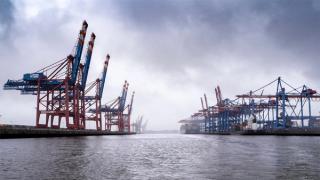Globalisation has suffered a severe setback as a result of the COVID-19 pandemic.
Cross-border capital flows never fully recovered from the global financial crisis. This latest shock first hit the international movement of people, but the global economic downturn will inevitably reduce cross-border trade and investment.
The pandemic hit a world economy that was already struggling with the consequences of a destructive trade war.
Global supply chains have been disrupted by shut-downs in the production of key components. These supply chains are highly optimised to business-as-usual conditions and are designed to keep inventories to a minimum to reduce costs.
A once-in-100-years pandemic is no reason to turn our back on the benefits of globalisation. However, it is an argument for building extra resilience and belatedly increasing pandemic preparedness.
International trade normally reduces vulnerabilities to localised shocks, but the global nature of the pandemic makes supply chain disruptions inevitable.
If anything, these disruptions dramatise the hidden benefits rather than the costs of globalisation.
The availability of the goods and services that we previously took for granted now seems less secure.
We can now see more clearly the extent to which our standard of living depends on integration with the global economy.
A once-in-100-years pandemic is no reason to turn our back on the benefits of globalisation. However, it is an argument for building extra resilience and belatedly increasing pandemic preparedness.
A power outage might be an argument for building a more resilient energy infrastructure, but it's not an argument against the ongoing benefits of electricity.

Australia was the lucky country
Australia's economy has endured de-globalisation shocks in the past.
The period from 1890 to 1940 saw a negative terms of trade shock that triggered a depression in the 1890s that was followed by the Great War of 1914-18 and the Great Depression of the 1930s.
Australia was not spared the Spanish flu in 1919, although the slower pace of international travel gave Australia more time to prepare for its inevitable arrival.
The 50 years of subdued economic growth from 1890 to 1940 stand out because they followed a period in which Australia enjoyed the world's highest standard of living.
In the late 19th century, Australia had a standard of living 50 per cent above the United States. Labourers in Sydney enjoyed wages double those found in Chicago or San Francisco.
Australian defined the frontier of global living standards in the 19th century because it enjoyed world-beating levels of productivity, coupled with relatively high rates of labour force participation.
This productivity in turn reflected a high degree of integration with a then rapidly globalising world economy.
We had global influence back then
Australia was a globally significant destination for both international capital and migration.
Australia was more globalised in the 19th century on some metrics than it is today. The internationally-traded share of the Australian economy was higher and Australia only recently recovered the foreign-born share of the population it benefited from more than 120 years ago.
Failure to converge? The Australia-US productivity gap in long-run perspective

After the disastrous inward turn around the time of Federation and the era of de-globalisation from 1914 to 1945, Australia benefited from the rise of the postwar multilateral trading system and post-war migration, but still remained inwardly focused compared to the previous century.
It was not until the reform period starting in 1983 that the Australian economy was re-internationalised and joined a new wave of globalisation that not only raised Australian productivity and living standards, but lifted a billion people out of poverty globally over the last quarter century.
Since the mid-2000s, the pace of both globalisation and productivity has slowed at home and abroad.
These two trends are arguably linked.
Closing the productivity gap
Australia's productivity growth has been broadly in line with the global frontier represented by the United States, but the level of Australian productivity has remained stubbornly below the US.
The productivity gap largely accounts for Australia' shortfall in average living standards compared to the US.
There are structural impediments to Australia converging on US levels of productivity.
Australia has a different industry composition, a higher labour utilisation rate and a larger productivity penalty from geography than the US. But there is still scope to narrow, if not close, the productivity gap.
One way of narrowing the gap is to increase Australia's economic integration with the rest of the world.
Before the pandemic, Australia ranked only 58th internationally on one index of economic globalisation, just ahead of the United States at 59th.
But because the US is already on the frontier of global productivity, it is not as reliant on international economic integration to drive domestic productivity gains.
My research, Failure to Converge? The Australia-US Productivity Gap in Long-Run Perspective, suggests Australia could enjoy productivity gains of up to 9 per cent by positioning itself on the frontier of international economic openness.
In the wake of the pandemic, re-booting Australia's international economic integration must be a top priority for Australian policymakers.





